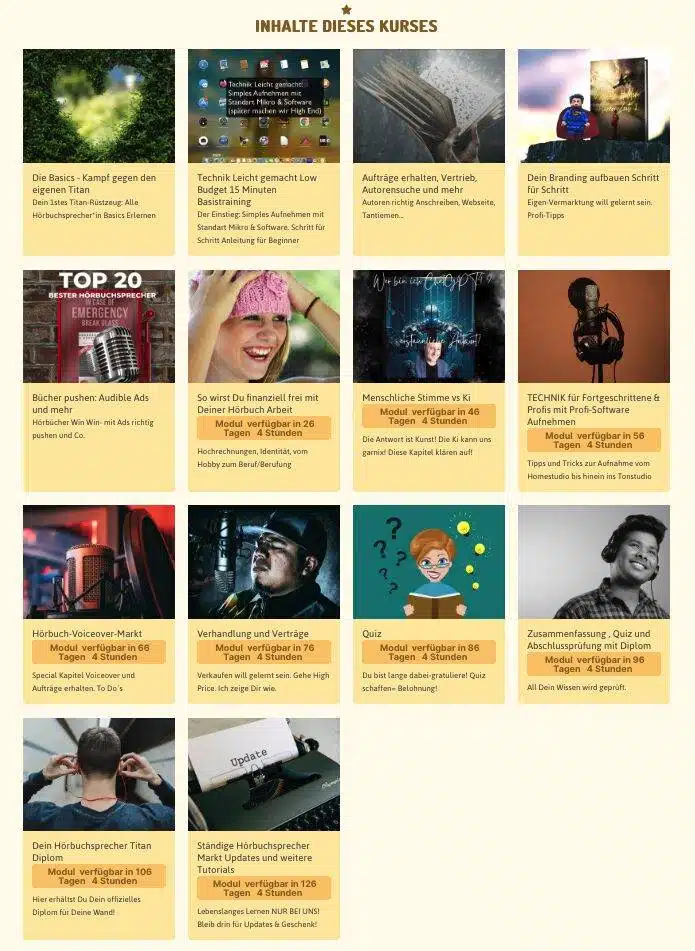Audibles Anforderungen an Hörbücher sind hoch. In diesem Blogartikel zeige ich dir in einer 15-minütigen praktischen Videolektion (ein kleiner Auszug aus der Ausbildung zum Hörbuchsprecher Titan), wie du mit dem günstigsten Equipment alles für Hörbücher auf Audible meistern kannst.
Hier erhältst du deine versprochene 15-minütige Grundausbildung, um deine Stimme auszuprobieren:
Nur die Grundlagen, um loszulegen. Kein professionelles Geplänkel: nur einfache Umsetzung, um über deine Schulter zu schauen. So kannst du mit dem günstigsten Equipment ein Hörbuch auf Audible stellen. Für alle, die einfach mal ausprobieren möchten, ob der Beruf des Hörbuchsprechers etwas für sie ist. Auch aus technischer Sicht – um ein paar Hürden zu überwinden und das Berufsbild des Hörbuchsprechers greifbarer zu machen. Feuer frei:
Zusammenfassend lässt sich sagen, dass du Audibles hohe Anforderungen für Hörbücher knacken kannst, weil…
… so kommst du auch durch:
- Minimale Kosten für Ausrüstung wie Mikrofon
- Einfach zu bedienende, kostenlose Aufnahme-Software
- Die richtigen 1:1-Einstellungen, um über die Schulter zu schauen
- Die Anleitung zur Rauschreduzierung
- Die richtigen Einstellungen, um bei Audible akzeptiert zu werden
- Plus: Der korrekte Export deiner MP3-Datei
Zu den professionellen Werkzeugen und Schneid-/Aufnahmetechniken bis hin zum Aufnahmestudio kommen wir später im Hörbuchsprecher Titan
Dies ist alles, was du wissen solltest, um zu starten.
Genau so habe ich klein angefangen und meine ersten Kunden überzeugt.
Ich denke, du kannst das auch, oder? Hier kommst Du zum Hörbuchsprecher Titan Onlinekurs (KLICK).
Übrigens: Audibles Designanforderungen für das Cover sind oft eine Hürde. Hier ein kurzer Exkurs:
Hier sind die Anforderungen, die ein Hörbuchcover erfüllen muss, um von Audible und anderen Plattformen akzeptiert zu werden:
- Unser Hörbuchcover muss quadratisch sein, mit einer Größe von mindestens 3000 x 3000 Pixeln und maximal 4000 x 4000 Pixeln, auf keinen Fall hochskaliert.
- Es darf unter keinen Umständen unscharf oder pixelig sein, das Kunstwerk muss klar und scharf sein.
- Wir sollten keine leeren Ränder als Füllmaterial verwenden, das Cover muss das Quadrat vollständig ausfüllen.
- Die Datei sollte im JPG-Format, im RGB-Farbmodus und mit mindestens 72 dpi sein.
- Titel und Untertitel müssen natürlich vorhanden sein, ebenso wie die Namen der Mitwirkenden und des Verlags, wenn sie in den Metadaten angegeben sind. Wenn es eine Serie oder einen Band gibt, können wir das auch auf dem Cover angeben, aber nur, wenn es bereits in den Metadaten steht.
- Keine zusätzlichen Informationen wie Länge, Format, URLs oder Codes auf dem Cover. Auch keine Logos anderer Marken oder der Name des Cover-Designers.
- Preisangaben wie „Sonderpreis“ oder „niedriger Preis“ sind nicht erlaubt, ebenso wenig wie Verweise auf physische Produkte.
- Und natürlich keine pornografischen oder anstößigen Bilder auf dem Cover.
- Wenn der Hintergrund überwiegend weiß ist, sollte am äußeren Rand eine schwarze Linie mit einer Dicke von 1 Pixel sein, um einen guten Kontrast zu gewährleisten.
- Unser Hörbuchcover kann sich durchaus vom Cover des E-Books oder Taschenbuchs unterscheiden, aber zur Wiedererkennung ist es oft gut, ähnliche Designs zu verwenden.
Es ist am besten, das Hörbuchcover professionell erstellen zu lassen, oder wir können es selbst mit Canva machen (aber nur in der kostenpflichtigen Version), da du hier die Größe und Qualität bearbeiten oder herunterladen kannst, um es auf Audible zu verwenden.
Mein ganz persönliches Fazit nochmal zusammengefasst zu allen Anforderungen von Audible:
Mach es einfach, auch wenn die Hürden „anfangs“ wirklich hoch erscheinen – am Ende sind sie es nicht. Du musst nur auf die kleinen Dinge achten und bitte immer aus der Perspektive deiner Zuhörer sehen: Sie wollen ein schönes Hörerlebnis genießen, da sie ihre Freizeit dafür nutzen. Und das ist heutzutage ein wertvolles Gut im tristen Grau unseres Alltags.
Hier sind die technischen Anforderungen von Audible, wenn du als Hörbuchsprecher ein Hörbuch hochladen möchtest, um Notizen zu machen (siehe auch im obigen Video):
- Audioformat: Das Hörbuch muss im MP3- oder Enhanced AAC (M4B) Hörbuchformat vorliegen.
- Bitrate: Die empfohlene Bitrate beträgt 64 kbps bis 128 kbps für Sprache und 256 kbps für Musik. Ich stelle immer 192 kbps ein und das verursacht nie Probleme.
- Mono oder Stereo: Die Audiodatei kann in Mono oder Stereo vorliegen. Mono ist für Sprache ausreichend, Stereo wird für Hörbücher mit Musik empfohlen.
- Abtastrate: Die empfohlene Abtastrate beträgt 44,1 kHz.
- Dateigröße: Eine einzelne Datei darf nicht größer als 170 MB sein. Wenn das Hörbuch länger ist, müssen die Kapitel in Dateien aufgeteilt werden.
- Kapitelmarkierungen: Es wird empfohlen, Kapitelmarkierungen in der Audiodatei zu haben, damit die Zuhörer leicht zwischen den Abschnitten navigieren können.
- Metadaten: Die Audiodatei muss die richtigen Metadaten enthalten, wie Titel, Autor, Albumtitel, Genre und Beschreibung des Hörbuchs.
- Coverbild: Wie bereits oben im Text erwähnt, muss das Hörbuchcover auch den Anforderungen entsprechen: quadratisch, mindestens 3000 x 3000 Pixel, JPG im RGB-Farbmodus usw.
- Korrekte Länge: Die Länge des Hörbuchs muss mit den im Upload-Prozess angegebenen Metadaten übereinstimmen.
- Qualitätssicherung: Es wird empfohlen, das Hörbuch vor dem Hochladen auf Qualität zu überprüfen, um sicherzustellen, dass es gut klingt und keine Störgeräusche oder Probleme aufweist.
Dies sind die grundlegenden technischen Anforderungen von Audible für das Hochladen eines Hörbuchs. Es ist wichtig, diese Richtlinien zu befolgen, um sicherzustellen, dass das Hörbuch reibungslos auf der Plattform erscheint und von den Zuhörern genossen werden kann.
Ich hoffe, dir hat diese umfassende Antwort gefallen und dieser Blogartikel wird dir bei deinen Aufnahmen für Audible helfen.
Ich hatte auch am Anfang ein paar Schwierigkeiten damit; Aber ich habe mich inzwischen mit Audible versöhnt (auch wenn sie manchmal immer noch wirklich lange brauchen, um zu veröffentlichen 🙂 ).
In diesem Sinne: Viel Spaß beim Erstellen! Die Antwort ist Kunst!
Liebe Grüße, dein Christian Gera
PS: Beginne deine Hörbuchsprecher-Ausbildung gleich hier (KLICK) oder diskutiere darüber in Deutschlands erster Hörbuchsprecher-Community auf Skool. Du bist herzlich eingeladen.
Bild von Felix Lichtenfeld auf Pixabay







